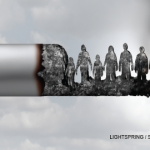
New York, 1960. Don Draper is facing a major dilemma. As creative director of the Sterling Cooper advertising agency, Draper must devise a strategy to sell cigarettes to an increasingly skeptical public concerned about the health risks of cigarettes. The release of the game-changing U.S. Surgeon General’s report, the first serious compilation of data to link smoking with cancer, was still years away. But Draper is growing frantic. He quickly rejects the suggestion made by his tobacco company client that some people might be drawn to smoking despite its health risks because of their urge to live dangerously. There must be a catchphrase that would highlight his client’s product while utterly disregarding the murmurings about smoking’s hazards. Then the jingle hits him: “It’s toasted!” referring to heat curing rather than sun drying of the tobacco leaf.
In fact, this clever slogan was shrewdly used for years by the American Tobacco Company to peddle its Lucky Strike brand. Ostensibly, toasting removed “harmful corrosive acids and sterilized the tobacco,” though in reality, it accomplished very little.1
Courting Doctors
Cigarette advertising played a prominent role in shaping American cultural mores and habits, as witnessed through the eyes of Draper and his co-workers on the critically acclaimed television series, Mad Men. Marketing campaigns were often based on pseudoscience. For decades, tobacco advertising consistently spouted hollow claims to hawk their deadly products. It’s astonishing to discover the complicity of the medical establishment in some of this egregious behavior.
A case in point was the marketing of Philip Morris cigarettes. After their manufacture, the tobacco in cigarettes gradually loses moisture, and the product becomes stale. All manufacturers add hygroscopic agents to help cigarettes retain moisture. In 1930, although glycerin was the preferred agent, Philip Morris used diethylene glycol instead. Despite the lack of any evidence, their marketing team decided to make this difference the central tenet of their advertising claims.2 They sought out Frederick Flinn, PhD, a faculty member at Columbia University in New York City, to produce supportive evidence. A controversial toxicologist, Flinn was best known for having served as an expert witness in the defense of watch manufacturers against claims that radium dial painters suffered ill effects from radiation toxicity. His made-to-order research concluded that irritation from diethylene glycol-treated cigarettes produced throat inflammation of less severity and shorter duration when compared with those moistened with glycerol.3 Full-page advertisements citing his “scholarly,” peer-reviewed publication appeared repeatedly in major medical journals, including the Journal of the American Medical Association. By emphasizing that doctors had scientific evidence to support the superiority of one particular brand of cigarettes, advertisers correctly assumed that sales would soar.
In fact, Don Draper would be proud. By implanting the concept of throat protection in the minds of doctors and the general population, profits from sales of Philip Morris cigarettes soared, tripling within the first year of the ad campaign.2
Not to be undone, the makers of Camel cigarettes probably did more than other companies to link their product with widespread physician acceptance. Their ads promoted the concept that when it came to smoking, “experience is the best teacher.” Using a series of print ads, Camel highlighted how personal clinical experiences often helped famous doctors gain insight into critical issues. Couldn’t this concept be applied when choosing a brand of cigarettes? For example, one ad depicted how the famous German physician and scientist, Paul Ehrlich, MD, reached some important conclusions in microbiology that “helped create the science of chemotherapy, which is increasingly important today.”4 (A prescient observation for a tobacco company!) The ad went on to assert that, “experience is the best teacher in cigarettes, too,” implying that wise doctors and their patients should flock to Camel cigarettes, too.
The nascent television networks were swamped with idyllic commercials depicting the hectic lives of doctors and how puffing on Camel cigarettes provided them with well-deserved downtime.5 White men (and yes, they were only white men) in white coats, some clutching stethoscopes, others with otoscopic mirrors strapped to their foreheads, were always reaching for a Camel. These are hilarious commercials to watch and nowadays would fit perfectly as sketches on Saturday Night Live, although at the time of their release, they served more sinister roles.
A Perfect Match: Stress & Cigarettes
Stress was becoming a growing concern in modern societies. Its critical role in health and illness was only starting to be understood. Two San Francisco cardiologists, Meyer Friedman, MD, and Ray Rosenman, MD, first proposed the idea of a stressful Type A personality, one that was prone to heart attacks and premature death. This notion of a stress-sensitive form of personality captured the American imagination, as well as the minds of the Big Tobacco executives. They realized a windfall opportunity by linking smoking with specific personality types. All they needed was some sympathetic scientific support, and they found it, from a most credible source, Hans Selye, MD, the father of stress. If tobacco executives were seeking to engage the services of a prominent physician-scientist, there was no better person to promote the link between stress reduction and smoking than Dr. Selye.
Dr. Selye’s research began with a handful of caged rats left freezing in a cold winter wind on a rooftop in my hometown, Montreal. They were part of a series of experiments conducted by Dr. Selye, a rising star in the worlds of physiology and endocrinology, who analyzed the reaction of rodents to a variety of stresses. A highly prolific investigator, he published more than 1,700 articles and 39 books during a 40-year career. Among his many discoveries were the recognition and designation of the glucocorticoid and mineralocorticoid actions of steroids, their effects on inflammation, and the discovery of calciphylaxis and its potential therapeutic effects. He authored several popular books about stress, including the bestseller, Stress Without Distress.
The shady relationship between Dr. Selye and the tobacco industry only came to light in 2002, following the creation of the Legacy Tobacco Documents Library. Situated at the University of California in San Francisco (UCSF), it houses and maintains internal corporate documents that were produced during litigation between 46 U.S. states and the seven major tobacco industry organizations. These previously unknown papers shed light on the workings of Big Tobacco.
Companies were keen to propose the image of smoking as a scientifically approved diversion that could help avoid disease-causing stress.6 In fact, this reference to “diversion” reflected Dr. Selye’s belief that disease was the result of an unsuccessful adaption to environmental stimuli. He theorized that this stress could be counteracted by other stimuli, a process he called deviation. Dr. Selye proposed that smoking was an acceptable, if not ideal, form of deviation.7 In 1969, he was asked to testify before a committee of the Canadian Parliament about the hazards of smoking:7
For decades, tobacco advertising consistently spouted hollow claims to hawk their deadly products. It’s astonishing to discover the complicity of the medical establishment in some of this egregious behavior.
The question is not ‘to smoke or not to smoke,’ but to smoke or drink, eat, drive a car—or simply fret. Since we cannot discard our surplus energy, we must occupy it somehow often more damage is done by creating, through well-meant crusades of enlightenment, innumerable hypochondriacs whose main sickness is really the fear of sickness.
The UCSF archives also contain a series of damaging memos written by lawyers for the tobacco industry that shine an unflattering light on Dr. Selye:7
He is willing to write for us and wants us also to provide a suggested guideline. Dr. Selye should comment on the unlikelihood of there being a mechanism by which smoking could cause cardiovascular disease. Dr. Selye can point out that even if cigarette smoking had some carcinogenic effect it might account for only a markedly small number of deaths, the balance being the result of other influences.
These disturbing revelations have tarnished Dr. Selye’s legacy as a major scientific investigator. His reputation is irrevocably stained. History would prove his tobacco-stress theories wrong. By the time of his death in 1982, mounting evidence proved that the scientific links between smoking and cancer and cardiovascular disease were irrefutable.
Smoke in the Rheum
There are few odors more noxious than the reek of cigarettes on a patient’s clothing, especially for those of us who toil in windowless spaces. So why do people smoke?
Among the 6,000 components of inhaled smoke is the highly addictive drug, nicotine. Inhaled nicotine quickly binds to acetylcholine type receptors leading to the release of significant amounts of the neurotransmitter dopamine in the nucleus accumbens, a key area of the brain that triggers dependency behavior.8 Dopamine appeared very early in the course of evolution and is involved in many functions that are essential for survival of the organism, such as attentiveness, motivation, learning and memorization. But most of all, dopamine is a key element in identifying natural rewards for the organism, so the urge to keep puffing can be overwhelming. One cigarette begets another. The habit becomes an addiction, with dire consequences for the smoker.
Although oncogenesis and vascular damage are considered to be the major hazards of smoking, there are other very significant effects that rheumatologists have recently identified. The first association between smoking and rheumatoid arthritis (RA) was a serendipitous finding in a study examining oral contraceptive use in RA patients.9 Subsequent studies demonstrated a two to fourfold increased risk of RA among smokers.
Work done in Sweden and duplicated elsewhere has demonstrated that smoking is strongly associated with an increased risk of RA in those patients expressing anticyclic citrullinated peptide (anti-CCP).10 Smoking increased the risk of RA in those subjects with disease-associated susceptibility genes (DRB1 shared epitope [SE] alleles) through a mechanism involving the generation of disease-specific autoantibodies (anti-CCP antibodies), because smoking has an effect only in those patients in whom immune tolerance to citrullinated peptides is lost. In fact, smoking had no effect on RA risk in anti-CCP-negative patients even if they bore a double copy of the DRB1 SE allele. This raises an intriguing question: Can the incidence of RA in individuals at high risk for developing the disease be reduced by convincing them to never smoke or to quit smoking altogether? The efficacy of this behavior modification is currently being probed in a long-term study led by several colleagues of mine at Brigham and Women’s Hospital in Boston.
An Indelible Stain
The Inuit are native people who have lived for more than a thousand years in the frozen tundra of the Canadian Arctic. When necessary, they have to be flown to Montreal for advanced medical care, approximately a 1,300-mile flight. I remember my first encounter with an Inuit man who was referred for aortic valve replacement surgery. Although he lived as a seal hunter in a remote settlement, far from anywhere, his first request upon arrival in the big city was to find someone to deliver his government-issued smoking allowance, a carton of cigarettes. One look at his tobacco-stained fingers said it all. Tobacco wreaks havoc everywhere. It leaves an indelible stain—on hands, in mouths, lungs, hearts, arteries and even in joints. But sometimes, when it destroys credibility, its stain is invisible.

Simon M. Helfgott, MD, is associate professor of medicine in the Division of Rheumatology, Immunology and Allergy at Harvard Medical School in Boston.
References
- Stanford research into the impact of tobacco advertising. http://tobacco.stanford.edu/tobacco_main/images.php?token2=fm_st115.php&token1=fm_img3416.php&theme_file=fm_mt009.php&theme_name=It’s%20Toasted&subtheme_name=It’s%20Toasted.
- Jackler RK, Samji HA. The price paid: Manipulation of otolaryngologists by the tobacco industry to obfuscate the emerging truth that smoking causes cancer. Laryngoscope. 2012 Jan;122(1):75–87.
- Flinn FB. Some clinical observation on the influence of certain hygroscopic agents in cigarettes. Laryngoscope. 1935;45:149–154.
- Camel cigarette ad. http://171.67.24.121/tobacco_web/images/tobacco_ads/target_doctors/j_icons/large/icons_11.jpg.
- Camel cigarette ad. https://www.youtube.com/watch?v=D-y_N4u0uRQ.
- Legacy Tobacco Documents Library. http://legacy.library.ucsf.edu.
- Petticrew MP, Lee K. The ‘father of stress’ meets ‘big tobacco’: Hans Selye and the tobacco industry. Am J Pub Health. 2011;101(3):411–418.
- How drugs affect neurotransmitters. The Brain from Top to Bottom. http://thebrain.mcgill.ca/flash/i/i_03/i_03_m/i_03_m_par/i_03_m_par_nicotine.html#drogues.
- Vessey MP, Villard-Mackintosh L, Yeates D. Oral contraceptives, cigarette smoking and other factors in relation to arthritis. Contraception. 1987 May;35(5):457–464.
- Klareskog L, Stolt P, Lundberg K, et al. A new model for an etiology of rheumatoid arthritis: Smoking may trigger HLA–DR(shared epitope)–restricted immune reactions to autoantigens modified by citrullination. Arthritis Rheum. 2006 Jan;54(1):38–46.



